The Global Food Crisis and Technologies That Help to Cope with its Effects

How technologies enable companies and governments to find the solutions to mitigate the effects of crises.
Author: Ryan Berger, Marketing Manager at The AnyLogic Company
Contents:
- The reasons and effects of the global food crisis
- How can technologies contribute to sustainable agriculture?
- Drone applications in agriculture
- Food supply chain disruptions
- Forecast of the food crisis for 2022
- Humanitarian crises in developing countries: how to optimize logistics and reduce transportation costs
- Conclusion: simulation is an instrument for agricultural sector improvement and cost reduction
Overview
In this article, we will demonstrate how technologies such as simulation software enable companies and governments to find the solutions to mitigate supply chain disruptions and the effects of crises.
The reasons and effects of the global food crisis
As we see, geopolitical and economic crises in 2022 have caused a rapid increase in food prices. Also, the global political situation has influenced the significant supply shortages of key commodity crops, such as wheat, corn, and oil seeds around the world.
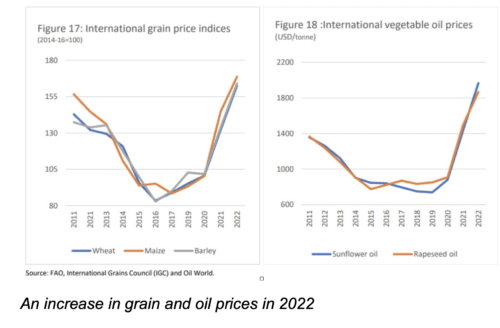
As Ukraine and Russia together, in 2021, exported 33% of the world’s wheat, 27% of barley, and 73% of the world’s sunflower oil (GRFC 2022), the instability from the Ukraine–Russia conflict affects the global food supply. This has created major uncertainties regarding the production and export capacities of agricultural products from Ukraine due to widespread infrastructure destruction. Severe repercussions are expected at the regional and global level, as many food-crisis countries depend on imports for staple food supplies and fertilizers.
Disruptions to natural gas and fertilizer markets will have a negative impact on production at the global level, especially at the beginning of a new planting season for many parts of the world. Limited availability or shortages of fertilizers are likely to reduce crop yields and result in poor local harvests, particularly in developing countries.
Supply chain disruptions and logistics challenges have caused price increases in fertilizer. The Russian Federation stood as the world’s top exporter of nitrogen fertilizers, the second leading supplier of potassium fertilizers, and the third largest exporter of phosphorous fertilizers (FAO, March 2022). It affects food production as well.
Rising prices for basic food items have already fueled protests in countries around the world, including Argentina, Indonesia, and Greece (Reuters).
In addition, the geopolitical situation has led to fuel price increases. A rise in fuel and transport prices has further increased the complexity of food distribution.
Many food-crisis countries, such as Middle Eastern, northern and sub-Saharan African, as well as South Asian countries, are reliant on wheat imports from Russia and Ukraine. According to the Global Report on Food Crises – 2022, in the event of an extended disruption to food imports from Ukraine and Russia, price increases are expected in food-crisis countries/territories.
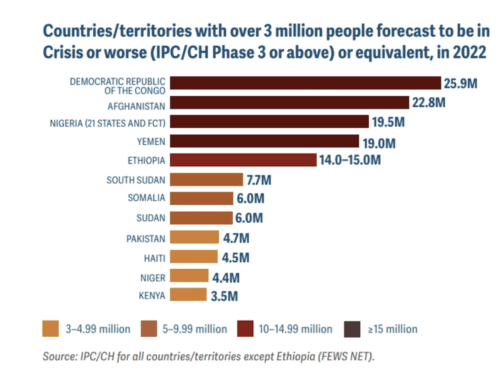
Food-crisis countries
Macroeconomics, weather shocks and food supply chain disruptions may intensify and prolong acute food insecurity conditions.
How can technologies contribute to sustainable agriculture?
Major food crises make farming innovation essential. The use of technology and technological innovation can improve the efficiency and output of agricultural processes. There are a lot of technologies that can be implemented with agritech investment.
The utilization of digital technology in agriculture may be transformative. People can use technology to be more accurate in the application of the fertilizer in the field. Increasing the efficiency of fertilizer use might help farmers deal with challenges that they are facing today. It will enable farmers to have good cropping seasons in future. Technologies could be applied from large to small farms.
Drone applications in agriculture
The proper use of drones for farming increases its efficiency and profitability. Drone deployment in the agricultural sector is useful for many tasks such as:
- GIS mapping
- Weed detection
- Crop health monitoring
- Harvest planning
- Storage security and monitoring
- Spraying pesticides and fertilizers
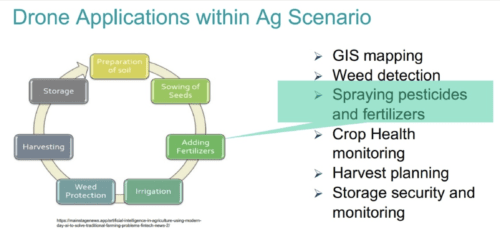
Efficient drone application in agriculture
For example, one of the Indian drone-based service providers used drones for spraying fields. For effective use of drones, consulting company BlueKei Solutions simulated with AnyLogic different scenarios of drone deployment.
The simulation modeling allowed the service provider to find out the number of drones needed without having wasteful redundancies. By using AnyLogic software for planning, the service provider can produce better crop yields. Find out more about using simulation modeling for efficient drone application in agriculture in the case study.
Food supply chain disruptions
Besides food production issues, there are a lot of logistics challenges due to the COVID-19 pandemic and the continuation of sanctions. These factors have significantly influenced food supply chains around the world and disrupted distribution channels at the consumption and distribution stages of the food industry.
Let us look at another example of technology application in the agricultural sector. In previous years, one of the world’s leading manufacturers and exporters of sunflower oil and provider of agricultural products from Ukraine faced challenges in planning, harvesting, and transportation of agro-products.
To analyze logistics operations and perform logistics network optimization in a risk-free environment to avoid extra costs the company used simulation modeling. The developed model helped optimize logistics operations and determine cost-optimized supply chain configuration.
For more details, read the case study on planning agro-industrial logistics with simulation software.
Forecast of the food crisis for 2022
The 2022 Global Report on food crises emphasizes the acute food insecurity in 2021 and alarmingly high levels of hunger in numerous food-crisis countries.
In 2021, around 193 million people or equivalent in 53 countries/territories were in crisis and in need of urgent assistance. This was an increase of nearly 40 million people from 2020. Major increases were reported in Afghanistan, Ethiopia, the Democratic Republic of the Congo, Nigeria, Pakistan, Yemen, Angola, and Somalia. This was a result of intensified conflict, significant economic shocks, and some of the most severe weather extremes in recent years.
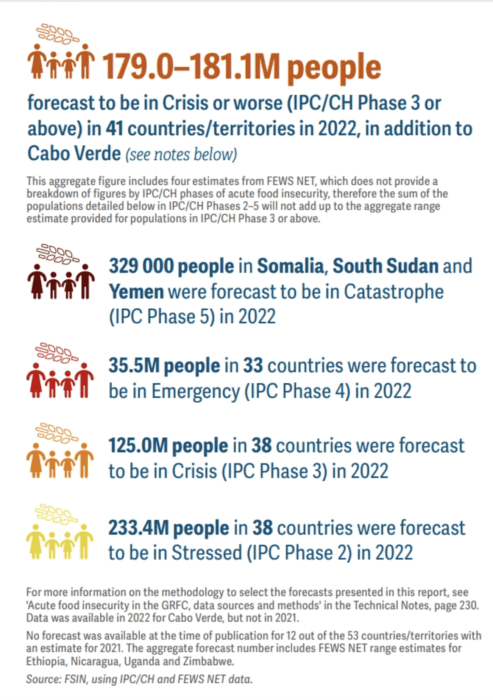
Forecast of the food crisis in 2022
As was reported in GRFC 2022, between 179 and 181.1 million people in 41 out of the 53 countries/territories were projected to be in crisis or worse in 2022. Around 329 000 people will likely face catastrophe in Somalia, South Sudan, and Yemen.
In addition, the impact of the protracted geopolitical conflict is expected to have severe consequences for food security outcomes.
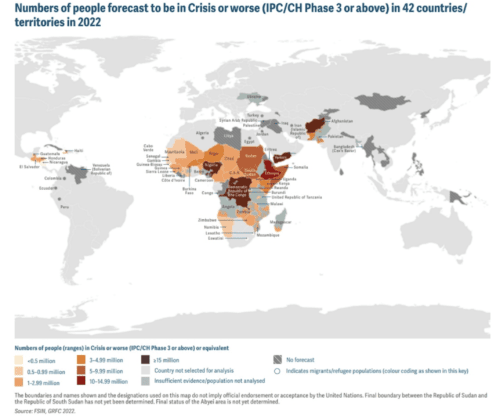
Countries/territories forecast to be in crisis in 2022
Humanitarian crises in developing countries: how to optimize logistics networks and reduce transportation costs
Logistics optimization is necessary for urgent and less expensive transportation to provide emergency responses for developing countries, such as Indonesia, with a poor logistics infrastructure.
One of the leading humanitarian organizations that builds logistics capabilities to cope with humanitarian crises faced a supply network design challenge. To address this challenge the anyLogistix (ALX) platform was chosen.
Using anyLogistix the optimal configuration for a supply network was defined. Also, the most appropriate locations and optimal flows across the nodes were selected. By focusing on network optimization, the capabilities were improved to cope with disasters. ALX Network Optimization allowed transportation costs to be reduced by 28%. Read more and look at the supply chain model in the case study on logistics network optimization for disaster management in Indonesia.
Conclusion: simulation is an instrument for agricultural sector improvement and cost reduction
Thus, the geopolitical, economic, and climate crises provoked the supply shortages, food and fertilizer price increases, and supply chains disruptions in the agricultural sector. To deal with the shortages of food supplies and increases in food prices, well-developed and developing countries will need to adopt innovative simulation technologies for agriculture and logistics.
Simulation software can help mitigate the effects of disruptions in food supply chains, optimize logistics operations, and produce better crop yields. These are important steps for sustainable agriculture, global hunger decrease, and the improvement of people’s well-being across the world.
